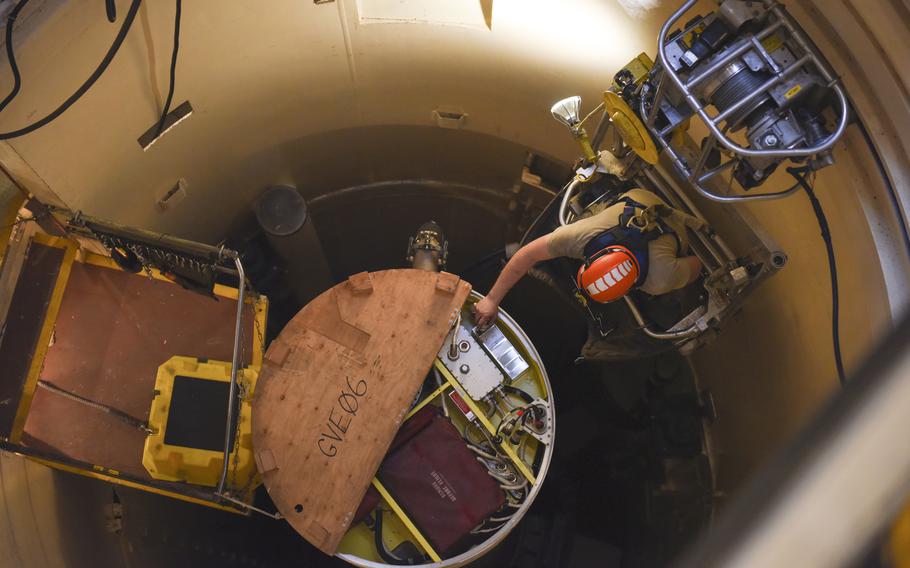
In this image provided by the U.S. Air Force, Airman 1st Class Jackson Ligon, 341st Missile Maintenance Squadron technician, examines the internals of an intercontinental ballistic missile during a simulated electronic launch Minuteman test Sept. 22, 2020, at a launch facility near Malmstrom Air Force Base in Great Falls, Mont. The Sentinel project, developed and managed by Northrop Grumman Corp., is meant to replace 1970s-era Minuteman III missiles (Tristan Day/U.S. Air Force)
WASHINGTON (Tribune News Service) — The U.S. Air Force’s new intercontinental ballistic missile program is at risk of blowing past its initial $96 billion cost estimate by so much that the overruns may trigger a review on whether to terminate the project.
By one estimate, each of the ICBMS and related expenses, such as silo construction, may cost as much as 50% more than the current estimate of $118 million in 2020 dollars not adjusted for inflation. In theory, that could bring the cost for the 659 missiles planned to almost $117 billion.
The Sentinel project, developed and managed by Northrop Grumman Corp., is meant to replace 1970s-era Minuteman III missiles as part of a modernization of all three legs of the air-land-sea triad of nuclear weapons, in part to counter China’s expanding arsenal.
Although that initiative has substantial support in Congress, rising costs could trigger provisions of a 41-year-old law designed to warn lawmakers of troubled projects and force the Pentagon to formally reaffirm the program’s rationale or face its termination.
This week, the Air Force’s acquisition officials started a review after the Sentinel program office at Hill Air Force Base in Utah submitted a “Program Deviation Report” to Air Force headquarters. “New information has emerged about factors that are driving changes to important aspects of the program, from the cost of materials and labor for the design and timeframe needed to build the launch facilities,” Andrew Hunter, the Air Force’s acquisition chief, said in a statement to Bloomberg News.
“We’re in a different world now than when program costs and schedules were originally set as a baseline” in August 2020, Hunter said. “Revisiting our assessments ensures senior leaders are equipped with updated information required to make decisions,” he said.
Although the Sentinel program is seen as a key deterrent against China, any major delay or cost increase may embolden arms control advocates such as Democratic Sen. Elizabeth Warren of Massachusetts who have pressed for its termination in favor of extending the life of Minuteman III missiles.
The question is whether the Sentinel program will exceed its original cost benchmarks beyond thresholds established in a 1982 law named after former Sen. Sam Nunn and former Rep. David McCurdy. It requires the Pentagon to inform Congress and extensively justify any program when costs exceed the original estimate by 15%, 25% or as much as 50% depending on the categories measured — in this case as reflected in the cost of an ICBM.
The Air Force review will take about 45 days before a determination is made as to whether the ICBM program exceeds the law’s cost thresholds, the service said in a statement.
If the Air Force and Pentagon conclude the new cost numbers will exceed the law’s thresholds, the service must inform Congress and conduct a major assessment as to whether the program should survive or face termination. To continue, the Pentagon would probably have to request more funds to cover the projected cost increase — triggering a major new debate.
One of the biggest challenges is the mammoth cost of construction and materials transportation to convert 450 Cold War-era Minuteman III missile launch facilities and 24 launch centers for Sentinel installation. This task, “estimated to last nearly 10 years, will be a lengthy and complicated process involving real estate purchases, construction, deconstruction, removal and installation of equipment and nuclear certification,” the Senate Armed Services Committee said in its fiscal 2024 budget report.
Additionally, the project will require installing more than 7,500 miles of underground fiber cable connecting silos constructed across U.S. missile wings, spanning five states.
Depending on what costs are included, the current benchmark estimates range from $75 million to $118 million per missile today. For example, the $118 million figures reflect what’s known as the “Program Acquisition Unit Cost” — or the total cost of development, procurement and construction divided by the number of units to be purchased.
The Air Force declined to say whether Northrop Grumman was experiencing any performance issues in the current engineering development phase that might affect the new cost projections.
Northrop said in a statement that “we are closely partnered with the Air Force as we continue to progress on” development milestones and “together mature the design and reduce risk.”
Northrop, the prime contractor, currently leads the Sentinel design phase and may eventually receive production contracts for the missile and management contracts to oversee the massive construction phase.
©2023 Bloomberg L.P.
Visit bloomberg.com.
Distributed by Tribune Content Agency, LLC.